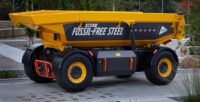LONG BEACH, CA—Relativity Space, the first company to 3D print an entire rocket, recently announced that $650 million in new funding enables it to begin production on the Terran R, its fully reusable, entirely 3D-printed launch vehicle. The Series E equity funding round is led by Fidelity Management & Research Company LLC, with participation from investors including accounts managed by Mark Cuban.
“Just five years ago, we planned on 3D printing Terran 1 and then Terran R–a 20-times-larger fully reusable rocket–on our Factory of the Future platform,” says Tim Ellis, CEO and co-founder of Relativity. “Together with our first rocket Terran 1, our second product, Terran R, will continue to take advantage of Relativity's disruptive approach to 3D printing–reduced part count, improved speed of innovation, flexibility, and reliability–to bring to market the next generation of launch vehicles.
"Relativity was founded with the mission to 3D print entire rockets and build humanity’s industrial base on Mars," continues Ellis. "We were inspired to make this vision a reality, and believe there needs to be dozens to hundreds of companies working to build humanity’s multiplanetary future on Mars. Scalable, autonomous 3D printing is inevitably required to thrive on Mars, and Terran R is the second product step in a long-term journey Relativity is planning ahead.”
Created in Relativity’s Factory of the Future by the same printers as Terran 1, Terran R has unique aerodynamic features with algorithmically generated and optimized structures. The company’s proprietary 3D printing process is enabled by software and data-driven manufacturing, exotic 3D printed materials, and unique design geometries that are not possible with traditional manufacturing, driving a faster rate of compounding progress and iteration in the industry.
As a two-stage, 216-foot-tall rocket with a 16-foot diameter, and a 5-meter payload fairing, Terran R will be fully reusable including its engines, first stage, second stage, and payload fairing, and will be capable of launching more than 20,000 kilograms to low Earth orbit (LEO) in a reusable configuration. Terran R will be outfitted with seven entirely 3D-printed Aeon R rocket engines capable of 302,000-pounds of thrust each, while its upper stage houses one Aeon Vac engine, with a pathfinder engine having already completed full duration testing at the beginning of this year.
Aeon R is a scaled, high pressure version of the gas generator cycle Aeon 1 already planning to fly on Terran 1, and similarly uses cryogenic liquid methane and oxygen propellants and runs with autogenous tank pressurization. Starting in 2024, Terran R will launch from Launch Complex 16, the company’s site at Cape Canaveral, where Terran 1 is also set to launch this year.
Combined with the ability to launch 20X more payload than Terran 1, Terran R provides both commercial and government customers affordable access to space, in LEO and beyond. With low earth orbit, medium earth orbit and geosynchronous satellite constellations representing the largest part of the growing market, Terran R helps accommodate the company’s growing pipeline of commercial interest, including the recent signing of its first anchor customer launch contract for Terran R. Relativity’s radically simplified supply chain enables the company to print its rockets with 100 times fewer parts in less than 60 days.



